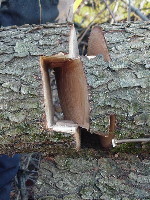I was reading in Tim Ard, and Mike Bolin's book
The
Complete
Guide to
Chain Saw Safety
and
Directional Felling
http://www.forestapps.com/e-book/index.html
About the "Block" or "Step" notch and I was intriqued by some of the control posibilites that this notch offers. One thing the book did not mention was where the back cut should be made. It makes resonable sense to me that the back cut should be even with the top cut of the notch (see pic).
Has anyone here ever used this notch or know anything about it. How about some one on the West Coast the book says thats where this notch was developed?
Thanks
The
Complete
Guide to
Chain Saw Safety
and
Directional Felling
http://www.forestapps.com/e-book/index.html
About the "Block" or "Step" notch and I was intriqued by some of the control posibilites that this notch offers. One thing the book did not mention was where the back cut should be made. It makes resonable sense to me that the back cut should be even with the top cut of the notch (see pic).
Has anyone here ever used this notch or know anything about it. How about some one on the West Coast the book says thats where this notch was developed?
Thanks








